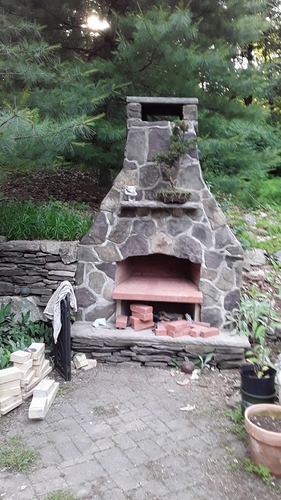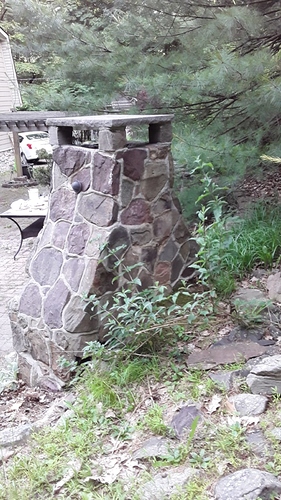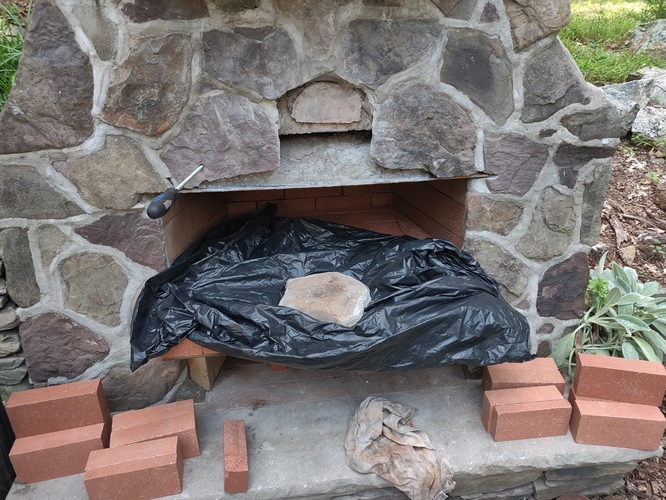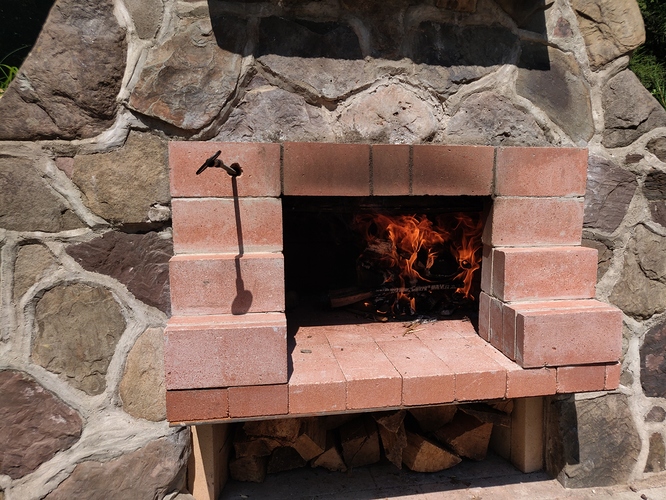We are converting a fireplace into a wood burning pizza oven and thinking of lining the inside of the oven with ceramic fiber blanket; this would obviously subject the blanket to direct heat and possibly flames. Would this be safe? This has been a really fun challenge, check out our progress below!
That’s a huge negative ghost rider…at this point you’re talking either a re-build, or just enjoy the oven for what it will be, probably maxing out at 400-600 degrees instead of 800-1000. Not quite the classic pizza oven, more like your kitchen oven outdoors which is still pretty cool.
@Carlos do you say that because the ceramic fiber would just burn? Any tips on ways to insulate it/get the heat as high as possible?
An un-sealed ceramic blanket would give off dust, which would be a huge silicosis risk! Talk about killer pizza! Just Google silicosis and ceramic fiber blanket and you’ll see exactly why. If you want to use a ceramic blanket in reverse you would have to engineer it in reverse…basically find some way to attach blanket to inside wall (fire mortar maybe) and then build in backwards a firebrick wall (talk about challenging brickwork). Make sure to always use an N-95 grade mask when working with any insulation, but especially glass-based ones like a fiber blanket. Can’t repair lung damage.
That’s a good idea @Carlos. We’ve been using Heat Stop refractory mortar to build the oven, what if we covered the blanket with this? This would also effectively adhese it to the wall.
Welcome to the BrickWood forums!
Before you go the ceramic fiber route…I’m wondering about the structure I see in the photo. The photo is pretty tightly cropped (to the point that I can’t tell whether this is located indoors or outdoors).
But it looks like the existing fireplace has a standard lined firebox. Do you have access behind it?
A photo or two of the overall setting and the back of the fireplace would help here.
Intriguing!
@bikerbudmatt it’s outside, and as you’ll see from the picture I don’t have access behind it. As the space above the oven floor and the chimney above is so large (I’ll post another pic in another post as I can only attach 1), I’m concerned about losing most of the heat. Any thoughts??
Hi Daniel,
Well, that is indeed an enormous volume above the box.
As @Carlos pointed out it’s just going to be tough without a rebuild. You can get as much insulation as possible into the side walls, but your heat is going to escape through that opening.
One wild thought that comes to mind is casting a dome with a top vent, building a support ridge just under the base of the chimney box, and inserting the dome up into it. You might have the space, and while it still wouldn’t perform like a purpose-designed wood fired pizza oven, it would come a lot closer.
But that’s way beyond my skill level. @BrickWood might be able to expand on it or at least tell us why it wouldn’t work. 

It’s an interesting project @Dankrohn. I can see why the original structure appealed to you and I hope there is a way for it to work out for you both!
@bikerbudmatt @Carlos We ended up getting a metal sheet fabricated to place above the oven floor, then insulating it with ceramic fiber blanket and mortar. We fired it up yesterday and only got to any 500 degrees. Any tips on technique for wood lighting/placement in the oven to maximize heat? Pics below. Thanks!
Fire looks good, although hard wood is recommended I would use Pine or cedar since they burn extremely hot. It’s going to be really tough to get much above that since without insulation all around the rocks will be sucking the heat out. Couple of questions…are those standard bricks or firebricks? Do you have a removable door? Is there still a chimney hole inside of oven space? Is there a ceramic fiber blanket on the bottom?
-if those are standard bricks then DEFINITELY replace with firebricks to keep heat
-if no door then I would make one to allow heat to build inside, but still allow oxygen to get sucked in at bottom of door
-if you fully covered the chimney hole up then the air flow will be limited, which would also limit convection cooking air current and heat output
-if no fiber blank underneath then I would not use it as my wood storage and would rebuild the floor with true insulation, otherwise it will be a heat-sucker
…a raging fire for a few hours beforehand may be whats needed to heat up the whole structure basically now, and having the fire in the front until you’re ready to cook…then push to the back so the bricks are super-hot underneath the pizza. Also the door is a balance thing…keeping heat in, wind out…but allowing the air in as well to fee the fire (however without an internal vent/chimney it won’t work that way).
…that’s my 2 cents with my limited knowledge, good luck!
I think you’re on the right track, and @Carlos has already asked some great questions. I see the rod at top left, which looks like it connects to a damper, yes? The bricks look like firebrick, and I agree that if they are not, you need to replace at least the ones on the floor. My recollection is that the back of the original fireplace was already lined.
You are really going to have to soak that structure with heat. I’m still not clear from your description where you placed the ceramic fiber insulation. The stones for the fireplace will definitely warm over time, but the original fireplace design was not trying to refract and reflect heat back into the main burning space. So, if there is no thermal break between firebox and stones, they will still act as an enormous heat sink.
The opening is still enormous by oven standards. Would you consider closing off about 30 percent of that area (sides and top)? You could do that with firebrick (take a peek at the Mattone Barile directions, near the end where an optional closing build is described…it’s for an arch but it would be easier in your case).
And I agree, unless there is an insulative layer between the oven floor and the space underneath, wood or any other combustible material should not be stored there.
Keep talking to us, Dan! You’ve already got a 500-degree head start on this.
Thank you guys so much for your reply, it’s super helpful. @bikerbudmatt the ceramic blanket is on the steel plate that we placed above the cooking surface, just below the chimney (the picture below shows it). And yes, that rod goes to a 6" wide damper that we built into the steel plate.
We are going to get a door made as you suggested, as well as figure out a way to insulate the space below the oven floor. Do you think the ENTIRE space needs to be insulated? Or just a layer of ceramic fiber blanket will do? We will obviously surround the blanket with something, most likely mortar. @Carlos
Yes, it will help. Unlike the builds we generally discuss, there is just air under the floor. The firebrick by themselves won’t be enough to retain the heat you need for a good bake. And I’ve gotta say that I’m not sure you’ll ever get that the way you would from a purpose-built oven, but I think you can improve it quite a bit from your starting point.
Hope that’s helpful, Dan!
I’m thinking 2-3 inches of ceramic fiber blanket since you’re not going to have the insulating base that these other designs have. The metal will otherwise be a constant heat sucker. Also the door needs to really be designed well for this application…plenty of air sucking in the bottom, but the top sealed off to keep heat in and create the convection. Then you may get 200-300 more out of it with a raging fire!






